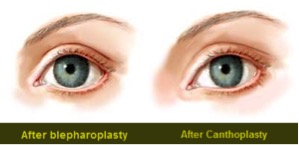Excess skin and bags are usually the tell-tale signs of aging that prompt patients to seek cosmetic eyelid surgery. There are various surgical techniques to address these stigmata of gravity and father time. The third factor that affects the appearance of the eye is its shape – an important attribute of the youthful eye that patients, and often surgeons, fail to recognize and address.
The shape of the eye is determined by the relation of the upper and lower eyelids (or palpelbrae) The space between the upper and lower lids that frames the ocular globe is referred to as the palpebral fissure. In young adults with normal facial skeletons, the palpebral fissure is long and narrow (see youthful). Distortions of, or deviations from, this shape may be secondary to heredity, aging, paralysis, trauma or previous surgery. Aging results in, gravitational descent of the lower lid and medial migration of the lateral canthus (lateral corner of the palpebral fissure) and rounds the shape of the eye . (see Aging).
Standard blepharoplasty techniques which remove lower eyelid skin (and often muscle) tend to drop the lower lid margin, further rounding the palpebral fissure (see after Blepharoplasty). Newer blepharoplasty techniques including arcus marginalis release with fat transposition have been designed to avoid the rounding of the palpebral fissure.
There are two related procedures: canthopexy and canthoplasty - which are used to elevate the lower lid which has already fallen or to prevent it from falling during a lower eyelid procedure. Canthoplasty procedures, by design, alter the shape of the palpebral fissure since they disassemble and reassemble the lateral canthus while shortening the lower lid margin. This shortening of the lower lid results in a rounder eye shape (see After canthoplasty). Canthoplasty procedures may be appropriate for certain post traumatic situations or when the lower lid has become lengthened with age (senile ectropion). However, as the diagram (After canthoplasty) shows, the shape of the eye becomes rounder. For that reason, in my opinion, canthoplasty procedures should be avoided in cosmetic eyelid procedures.
Lateral canthopexy is the surgical repositioning of the lateral canthus. The lateral canthus (lateral corner of the palpebral fissure) is moved laterally and pexed (attached) to the lateral orbital rim. Since it does not violate the lid margin, it maintains, or has the potential to restore, palpebral fissure shape including the lateral canthal angle. By restoring a normal eye shape it makes the eye more youthful.
So, when considering eyelid surgery be aware that eye shape is just as important as bags and wrinkles defining a young attractive eye.
























